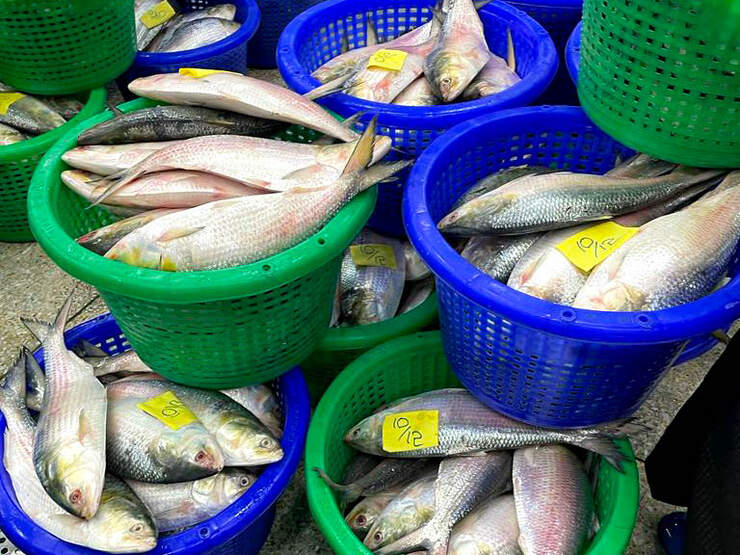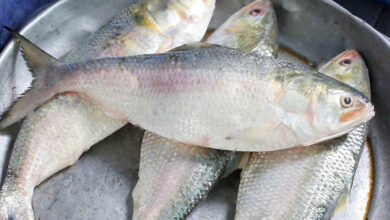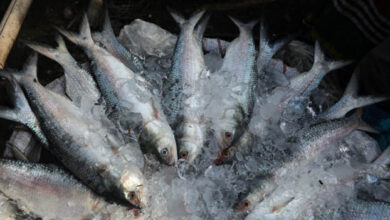
In the bustling food market of Singapore, the supply of essential items like Hilsa fish, meat, eggs, and vegetables largely hinges on imports from countries including Myanmar, Bangladesh, Pakistan, India, and Malaysia. Notably, the lion’s share of fish imports in the city-state is sourced from Myanmar, making it an intriguing aspect of the local food scene.
Expatriates from Bangladesh, India, and Myanmar are among the primary consumers of these imported fish in Singapore, creating a vibrant market for these culinary delicacies.
The streets of Singapore, especially those around Mustafa Centaur in Little India, are adorned with markets where a substantial population of Bangladeshi and Indian expatriates resides. These markets have become a hub for the procurement of these imported food items.
For instance, the E-Hong Mini Mart, a China-based shop located in Little India, sells three pieces of Hilsa (Tenualosa ilisha) fish for SGD $10. To put this in perspective, one Singapore dollar equals BDT 80.83 (SGD $1 equals US $0.73) according to the exchange rate set by the Bangladesh Bank. (News: The Business Post)
When it comes to Hilsa fish, it’s all about the weight. Three-piece Hilsa fish packets typically range from 1.3 to 1.4 kilograms, resulting in individual Hilsa fish weighing between 433 and 470 grams. This allows Bangladeshi and Indian expatriates in Singapore to indulge in Hilsa at a price point of SGD $7.83 or BDT 630 (US $5.71) per kilogram. Slightly larger Hilsa fish packets, weighing between 500-700 grams, are priced at SGD $14 or BDT 1126 (US $10.26), equating to a cost of BDT 475-540 (US $4.31 – $4.90) per kilogram. Where as in Bangladesh’s local wet markets, 1kg of Hilsa fish weighing 500-700 grams are being sold at BDT 850-1200 (US $7.71-10.88).
Singapore’s fish market presents unique challenges for those involved in the import and sale of these seafood delicacies. Despite Bangladesh being a significant producer of Hilsa fish, the primary source for farmed fish (like Catla, Rohu, Butter fish etc), including hilsa, in Singapore is Myanmar.
Shariful Ahmed, the Managing Director of E-Hong, explains, “As there is no approval for Hilsa export from Bangladesh to Singapore, we are compelled to procure it from Myanmar. Our customer base for Hilsa includes expatriates from Bangladesh, Myanmar, and India, and we price our Hilsa products strategically to ensure not only a break-even but a substantial profit margin.”
The international Hilsa trade also faces the complexities of high costs and certification processes. Sakhawat Hossain Sharif, in-charge of Commodity Connect, notes, “Importing fish directly from Bangladesh is impractical for two main reasons. Firstly, the prices in Myanmar are considerably more competitive compared to those in Bangladesh, making it challenging to conduct business by sourcing from Bangladesh.”
Another significant challenge is the extended certification process in Bangladesh, coupled with logistical complexities. This often results in a considerably longer timeline when sourcing fish from Bangladesh, which can take up to a week due to various complexities and a lack of cooperation from officials in the Department of Fisheries.
Global Hilsa fish production
In a global context, Bangladesh is a significant contributor to Hilsa fish production, accounting for 65 percent of the world’s total. India follows with 15 percent, while Myanmar, along with countries bordering the Arabian Sea, Pacific, and Atlantic Oceans, makes up the remaining 10 percent. This highlights the significance of hilsa fish in the global market and the pivotal role Bangladesh plays in its production.
The challenges in exporting and the shifting dynamics of the Hilsa trade have had repercussions for Bangladesh. According to data from the Export Promotion Bureau (EPB), export earnings from frozen and fresh fish, including shrimp, decreased by 21 percent to $42.2 million in the last fiscal year. The evolving dynamics of the hilsa trade underline the complex interplay of international markets, regulations, and consumer demand.




